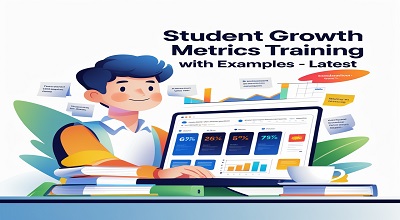Student Growth Metrics Training
Student Growth Metrics Training: In today’s data-driven educational landscape, measuring student growth metrics is essential for educators, administrators, and policymakers. These metrics help track progress, identify learning gaps, and implement targeted interventions. This comprehensive guide will explore student growth metrics training, providing real-world examples, best practices, and the latest trends to help educators maximize student success.
Whether you’re a teacher, school leader, or education professional, understanding how to measure, analyze, and apply student growth data can transform classroom instruction and improve outcomes.
What Are Student Growth Metrics?
Student growth metrics are quantitative and qualitative measurements used to assess a student’s academic progress over time. Unlike traditional grading systems, which may focus on static performance, growth metrics evaluate how much a student improves relative to their starting point.
Types of Student Growth Metrics:
- Standardized Test Scores (e.g., state assessments, NWEA MAP Growth)
- Formative Assessments (quizzes, exit tickets)
- Summative Assessments (end-of-term exams)
- Social-Emotional Learning (SEL) Metrics (behavior, engagement)
- Attendance & Participation Rates
These metrics help educators personalize learning, adjust teaching strategies, and ensure equitable progress for all students.
Why Are Student Growth Metrics Important?
Tracking student growth is crucial because:
✅ Identifies Learning Gaps – Helps teachers understand where students struggle.
✅ Informs Instruction – Allows for data-driven lesson planning.
✅ Supports Accountability – Schools and districts use growth data for funding and policy decisions.
✅ Encourages Student Motivation – Students see their progress, fostering a growth mindset.
According to a 2023 study by the National Center for Education Statistics (NCES), schools that consistently track student growth metrics see 15-20% higher achievement rates than those that don’t.
Key Student Growth Metrics to Track
Here are the most critical metrics educators should monitor:
A. Academic Growth Percentile (AGP)
Measures how a student’s progress compares to peers with similar past performance.
- Example: A student with an AGP of 75 has grown faster than 75% of their peers.
B. Value-Added Models (VAM)
Assesses a teacher’s or school’s impact on student learning.
- Example: A math teacher’s VAM score of +2.0 means students gained 2 extra months of learning compared to expected growth.
C. Benchmark Assessments
Periodic checks (e.g., quarterly tests) to gauge progress toward year-end goals.
D. Student Learning Objectives (SLOs)
Custom goals set for individual students or classes.
- Example: “80% of students will improve reading fluency by one grade level by May.”
Read Here: Quizizz 2025
How to Measure Student Growth Effectively?
To ensure accurate growth tracking, follow these steps:
1: Establish Baseline Data
- Use diagnostic tests at the beginning of the year.
2: Set Growth Targets
- Use SMART goals (Specific, Measurable, Achievable, Relevant, Time-bound).
3: Use Multiple Data Points
- Combine tests, projects, and classroom observations for a holistic view.
4: Analyze Trends & Adjust Instruction
- If most students struggle with fractions, revisit teaching methods.
5: Communicate Results
- Share growth data with students, parents, and administrators for transparency.
Examples of Student Growth Metrics in Action
1: Elementary Reading Progress
- Baseline: A 3rd-grade class averages Lexile Level 500 in September.
- Mid-Year: After targeted phonics instruction, average rises to Lexile 600.
- End-of-Year: Class reaches Lexile 700, exceeding district expectations.
2: High School Math Improvement
- Pre-Test: 45% of Algebra I students pass the first benchmark.
- Intervention: Small-group tutoring is introduced.
- Post-Test: Pass rate jumps to 78%.
These examples show how data-driven strategies lead to measurable growth.
Best Practices for Analyzing Student Growth Data
✔ Compare Cohorts – Track this year’s students vs. last year’s.
✔ Use Disaggregated Data – Check for equity gaps (e.g., ELL, special education).
✔ Leverage Visualization Tools – Graphs and dashboards make trends clearer.
✔ Focus on Growth, Not Just Proficiency – A student improving from F to C shows meaningful progress.
Latest Trends in Student Growth Assessment (2025)
- AI-Powered Analytics – Tools like GoGuardian and PowerSchool predict student performance.
- Competency-Based Growth Models – Focus on mastery rather than seat time.
- Real-Time Formative Assessments – Platforms like Kahoot! and Nearpod provide instant feedback.
Challenges in Measuring Student Growth & Solutions
| Challenge | Solution |
|---|---|
| Data Overload | Use dashboards to filter key metrics. |
| Inconsistent Assessments | Standardize benchmark tests. |
| Student Mobility | Track growth even if students transfer. |
Tools & Software for Tracking Student Growth
- NWEA MAP Growth – Adaptive assessments for K-12.
- Illuminate Education – Tracks academic and SEL growth.
- Google Classroom + Edulastic – Combines LMS with assessment analytics.
FAQs on Student Growth Metrics
Q1: How often should growth metrics be assessed?
A: Quarterly for benchmarks, weekly/monthly for formative checks.
Q2: Can growth metrics be used for teacher evaluations?
A: Yes, but they should be one of multiple measures, not the sole factor.
Conclusion
Student growth metrics are powerful tools for enhancing education. By tracking, analyzing, and acting on data, educators can ensure every student reaches their full potential.
Free Here: Jos889 APK
